D.light Design: Evaluating Channel Options for Indian Market
VerifiedAdded on 2022/09/09
|12
|2934
|22
Case Study
AI Summary
This case study examines the challenges D.light Design faced while entering the Indian market with its solar-powered LED lamps. The company, founded by Stanford Graduate School of Business students, aimed to provide affordable and consumer-friendly designs to address the lack of reliable electricity in rural areas. The assignment delves into critical issues like concentration in rural areas, the economic condition of the rural population, challenges of electrification, lack of literacy, building brand trust, product cost, and infrastructure limitations. It explores various distribution options, including rural entrepreneurs, village retailers, and partnerships with NGOs. The case requires an evaluation of channel options, considering end-user needs and potential channel conflicts, to determine the most effective strategy for D.light Design to succeed in the Indian market while balancing social and economic objectives. The analysis uses data to assess the financial viability of different approaches, emphasizing the need for a channel strategy that aligns with the low-income demographics and infrastructural challenges of the target market.
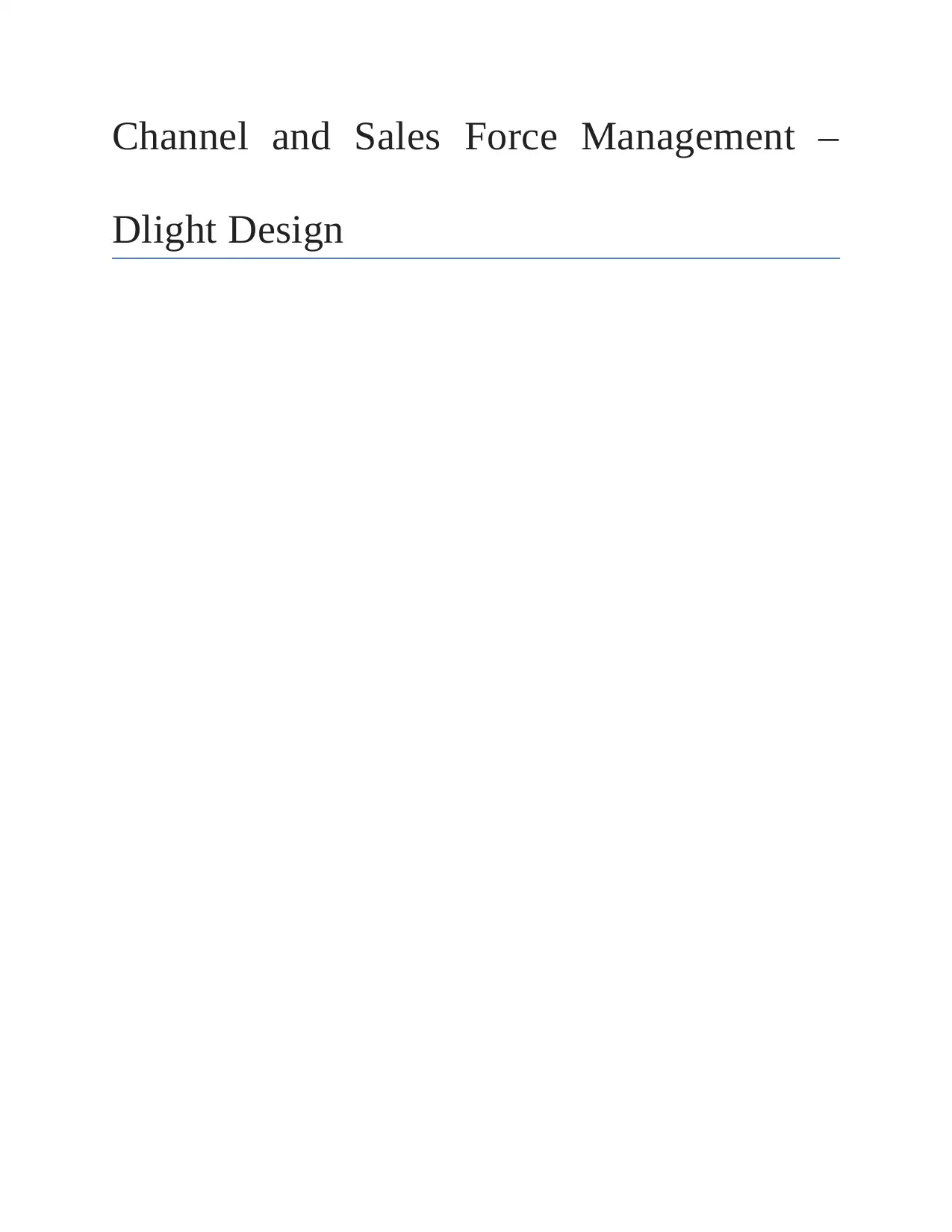
Channel and Sales Force Management –
Dlight Design
Dlight Design
Paraphrase This Document
Need a fresh take? Get an instant paraphrase of this document with our AI Paraphraser
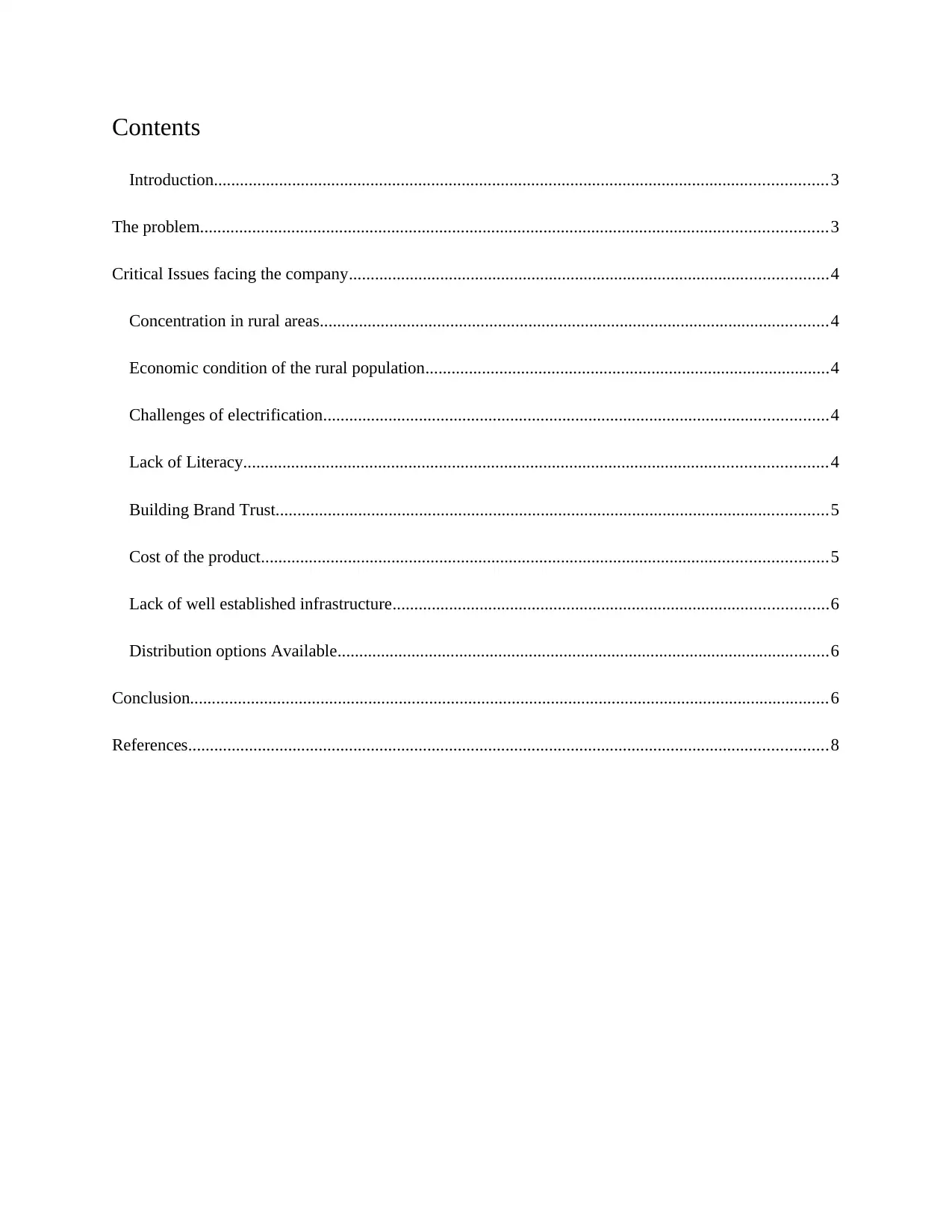
Contents
Introduction.............................................................................................................................................3
The problem................................................................................................................................................3
Critical Issues facing the company..............................................................................................................4
Concentration in rural areas.....................................................................................................................4
Economic condition of the rural population.............................................................................................4
Challenges of electrification....................................................................................................................4
Lack of Literacy......................................................................................................................................4
Building Brand Trust...............................................................................................................................5
Cost of the product..................................................................................................................................5
Lack of well established infrastructure....................................................................................................6
Distribution options Available.................................................................................................................6
Conclusion...................................................................................................................................................6
References...................................................................................................................................................8
Introduction.............................................................................................................................................3
The problem................................................................................................................................................3
Critical Issues facing the company..............................................................................................................4
Concentration in rural areas.....................................................................................................................4
Economic condition of the rural population.............................................................................................4
Challenges of electrification....................................................................................................................4
Lack of Literacy......................................................................................................................................4
Building Brand Trust...............................................................................................................................5
Cost of the product..................................................................................................................................5
Lack of well established infrastructure....................................................................................................6
Distribution options Available.................................................................................................................6
Conclusion...................................................................................................................................................6
References...................................................................................................................................................8
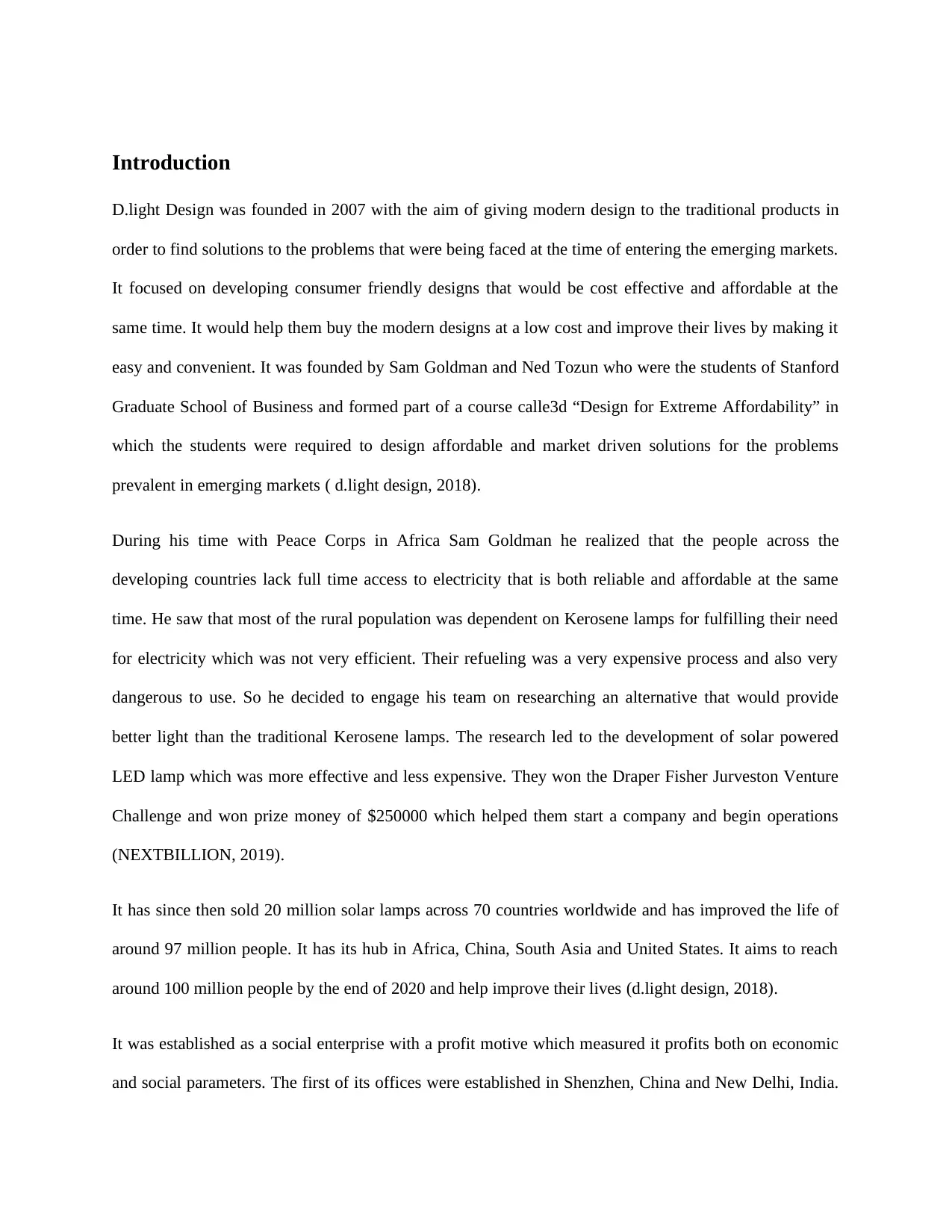
Introduction
D.light Design was founded in 2007 with the aim of giving modern design to the traditional products in
order to find solutions to the problems that were being faced at the time of entering the emerging markets.
It focused on developing consumer friendly designs that would be cost effective and affordable at the
same time. It would help them buy the modern designs at a low cost and improve their lives by making it
easy and convenient. It was founded by Sam Goldman and Ned Tozun who were the students of Stanford
Graduate School of Business and formed part of a course calle3d “Design for Extreme Affordability” in
which the students were required to design affordable and market driven solutions for the problems
prevalent in emerging markets ( d.light design, 2018).
During his time with Peace Corps in Africa Sam Goldman he realized that the people across the
developing countries lack full time access to electricity that is both reliable and affordable at the same
time. He saw that most of the rural population was dependent on Kerosene lamps for fulfilling their need
for electricity which was not very efficient. Their refueling was a very expensive process and also very
dangerous to use. So he decided to engage his team on researching an alternative that would provide
better light than the traditional Kerosene lamps. The research led to the development of solar powered
LED lamp which was more effective and less expensive. They won the Draper Fisher Jurveston Venture
Challenge and won prize money of $250000 which helped them start a company and begin operations
(NEXTBILLION, 2019).
It has since then sold 20 million solar lamps across 70 countries worldwide and has improved the life of
around 97 million people. It has its hub in Africa, China, South Asia and United States. It aims to reach
around 100 million people by the end of 2020 and help improve their lives (d.light design, 2018).
It was established as a social enterprise with a profit motive which measured it profits both on economic
and social parameters. The first of its offices were established in Shenzhen, China and New Delhi, India.
D.light Design was founded in 2007 with the aim of giving modern design to the traditional products in
order to find solutions to the problems that were being faced at the time of entering the emerging markets.
It focused on developing consumer friendly designs that would be cost effective and affordable at the
same time. It would help them buy the modern designs at a low cost and improve their lives by making it
easy and convenient. It was founded by Sam Goldman and Ned Tozun who were the students of Stanford
Graduate School of Business and formed part of a course calle3d “Design for Extreme Affordability” in
which the students were required to design affordable and market driven solutions for the problems
prevalent in emerging markets ( d.light design, 2018).
During his time with Peace Corps in Africa Sam Goldman he realized that the people across the
developing countries lack full time access to electricity that is both reliable and affordable at the same
time. He saw that most of the rural population was dependent on Kerosene lamps for fulfilling their need
for electricity which was not very efficient. Their refueling was a very expensive process and also very
dangerous to use. So he decided to engage his team on researching an alternative that would provide
better light than the traditional Kerosene lamps. The research led to the development of solar powered
LED lamp which was more effective and less expensive. They won the Draper Fisher Jurveston Venture
Challenge and won prize money of $250000 which helped them start a company and begin operations
(NEXTBILLION, 2019).
It has since then sold 20 million solar lamps across 70 countries worldwide and has improved the life of
around 97 million people. It has its hub in Africa, China, South Asia and United States. It aims to reach
around 100 million people by the end of 2020 and help improve their lives (d.light design, 2018).
It was established as a social enterprise with a profit motive which measured it profits both on economic
and social parameters. The first of its offices were established in Shenzhen, China and New Delhi, India.
⊘ This is a preview!⊘
Do you want full access?
Subscribe today to unlock all pages.

Trusted by 1+ million students worldwide
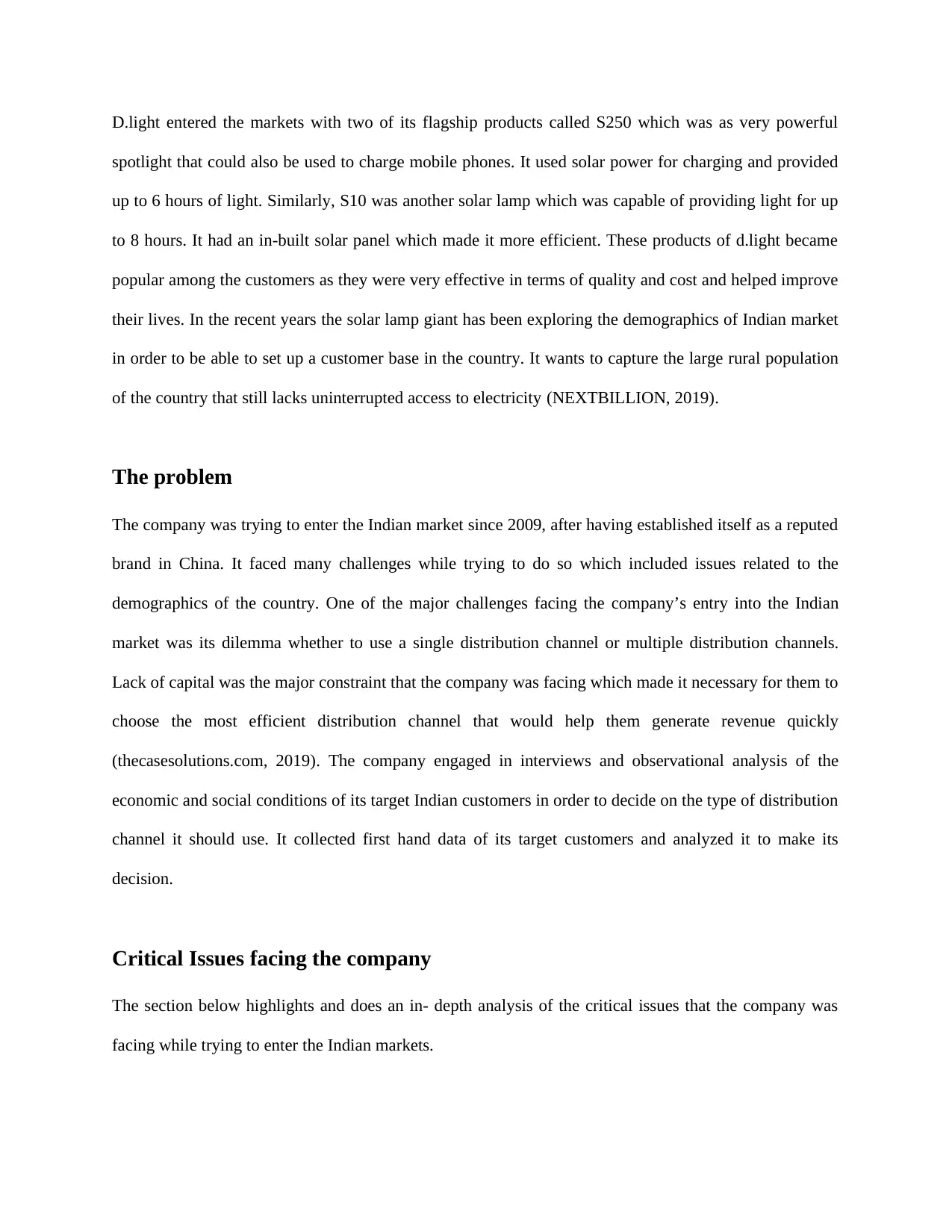
D.light entered the markets with two of its flagship products called S250 which was as very powerful
spotlight that could also be used to charge mobile phones. It used solar power for charging and provided
up to 6 hours of light. Similarly, S10 was another solar lamp which was capable of providing light for up
to 8 hours. It had an in-built solar panel which made it more efficient. These products of d.light became
popular among the customers as they were very effective in terms of quality and cost and helped improve
their lives. In the recent years the solar lamp giant has been exploring the demographics of Indian market
in order to be able to set up a customer base in the country. It wants to capture the large rural population
of the country that still lacks uninterrupted access to electricity (NEXTBILLION, 2019).
The problem
The company was trying to enter the Indian market since 2009, after having established itself as a reputed
brand in China. It faced many challenges while trying to do so which included issues related to the
demographics of the country. One of the major challenges facing the company’s entry into the Indian
market was its dilemma whether to use a single distribution channel or multiple distribution channels.
Lack of capital was the major constraint that the company was facing which made it necessary for them to
choose the most efficient distribution channel that would help them generate revenue quickly
(thecasesolutions.com, 2019). The company engaged in interviews and observational analysis of the
economic and social conditions of its target Indian customers in order to decide on the type of distribution
channel it should use. It collected first hand data of its target customers and analyzed it to make its
decision.
Critical Issues facing the company
The section below highlights and does an in- depth analysis of the critical issues that the company was
facing while trying to enter the Indian markets.
spotlight that could also be used to charge mobile phones. It used solar power for charging and provided
up to 6 hours of light. Similarly, S10 was another solar lamp which was capable of providing light for up
to 8 hours. It had an in-built solar panel which made it more efficient. These products of d.light became
popular among the customers as they were very effective in terms of quality and cost and helped improve
their lives. In the recent years the solar lamp giant has been exploring the demographics of Indian market
in order to be able to set up a customer base in the country. It wants to capture the large rural population
of the country that still lacks uninterrupted access to electricity (NEXTBILLION, 2019).
The problem
The company was trying to enter the Indian market since 2009, after having established itself as a reputed
brand in China. It faced many challenges while trying to do so which included issues related to the
demographics of the country. One of the major challenges facing the company’s entry into the Indian
market was its dilemma whether to use a single distribution channel or multiple distribution channels.
Lack of capital was the major constraint that the company was facing which made it necessary for them to
choose the most efficient distribution channel that would help them generate revenue quickly
(thecasesolutions.com, 2019). The company engaged in interviews and observational analysis of the
economic and social conditions of its target Indian customers in order to decide on the type of distribution
channel it should use. It collected first hand data of its target customers and analyzed it to make its
decision.
Critical Issues facing the company
The section below highlights and does an in- depth analysis of the critical issues that the company was
facing while trying to enter the Indian markets.
Paraphrase This Document
Need a fresh take? Get an instant paraphrase of this document with our AI Paraphraser
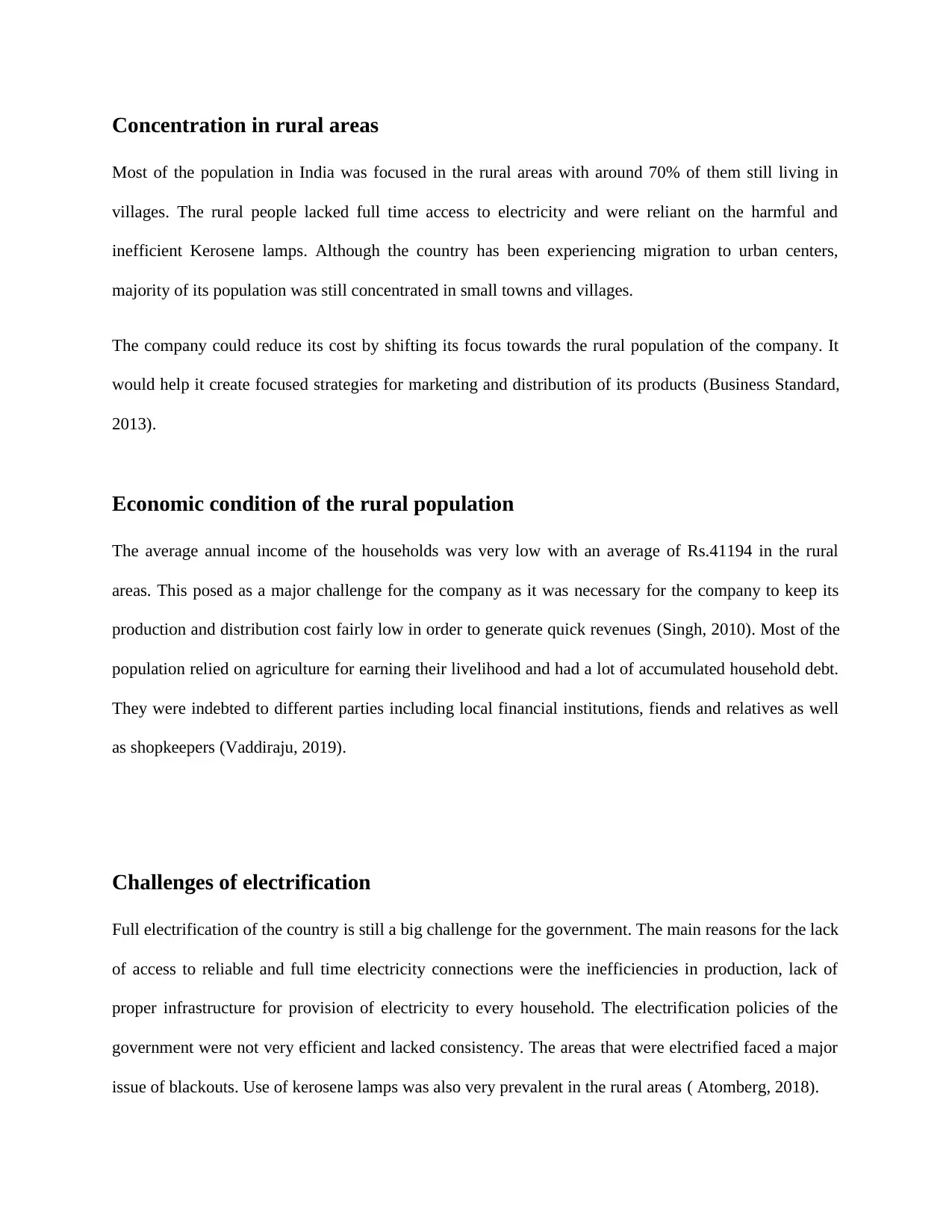
Concentration in rural areas
Most of the population in India was focused in the rural areas with around 70% of them still living in
villages. The rural people lacked full time access to electricity and were reliant on the harmful and
inefficient Kerosene lamps. Although the country has been experiencing migration to urban centers,
majority of its population was still concentrated in small towns and villages.
The company could reduce its cost by shifting its focus towards the rural population of the company. It
would help it create focused strategies for marketing and distribution of its products (Business Standard,
2013).
Economic condition of the rural population
The average annual income of the households was very low with an average of Rs.41194 in the rural
areas. This posed as a major challenge for the company as it was necessary for the company to keep its
production and distribution cost fairly low in order to generate quick revenues (Singh, 2010). Most of the
population relied on agriculture for earning their livelihood and had a lot of accumulated household debt.
They were indebted to different parties including local financial institutions, fiends and relatives as well
as shopkeepers (Vaddiraju, 2019).
Challenges of electrification
Full electrification of the country is still a big challenge for the government. The main reasons for the lack
of access to reliable and full time electricity connections were the inefficiencies in production, lack of
proper infrastructure for provision of electricity to every household. The electrification policies of the
government were not very efficient and lacked consistency. The areas that were electrified faced a major
issue of blackouts. Use of kerosene lamps was also very prevalent in the rural areas ( Atomberg, 2018).
Most of the population in India was focused in the rural areas with around 70% of them still living in
villages. The rural people lacked full time access to electricity and were reliant on the harmful and
inefficient Kerosene lamps. Although the country has been experiencing migration to urban centers,
majority of its population was still concentrated in small towns and villages.
The company could reduce its cost by shifting its focus towards the rural population of the company. It
would help it create focused strategies for marketing and distribution of its products (Business Standard,
2013).
Economic condition of the rural population
The average annual income of the households was very low with an average of Rs.41194 in the rural
areas. This posed as a major challenge for the company as it was necessary for the company to keep its
production and distribution cost fairly low in order to generate quick revenues (Singh, 2010). Most of the
population relied on agriculture for earning their livelihood and had a lot of accumulated household debt.
They were indebted to different parties including local financial institutions, fiends and relatives as well
as shopkeepers (Vaddiraju, 2019).
Challenges of electrification
Full electrification of the country is still a big challenge for the government. The main reasons for the lack
of access to reliable and full time electricity connections were the inefficiencies in production, lack of
proper infrastructure for provision of electricity to every household. The electrification policies of the
government were not very efficient and lacked consistency. The areas that were electrified faced a major
issue of blackouts. Use of kerosene lamps was also very prevalent in the rural areas ( Atomberg, 2018).
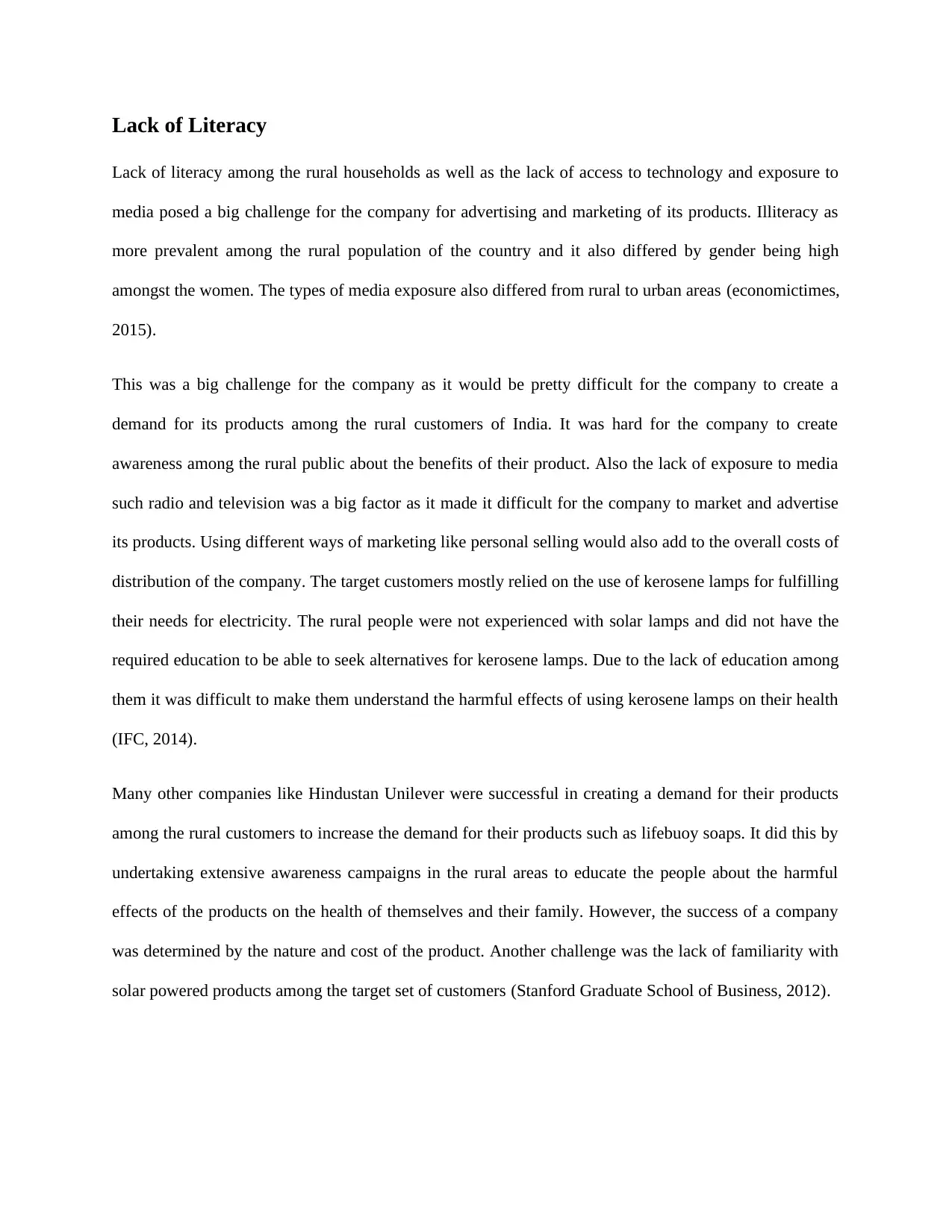
Lack of Literacy
Lack of literacy among the rural households as well as the lack of access to technology and exposure to
media posed a big challenge for the company for advertising and marketing of its products. Illiteracy as
more prevalent among the rural population of the country and it also differed by gender being high
amongst the women. The types of media exposure also differed from rural to urban areas (economictimes,
2015).
This was a big challenge for the company as it would be pretty difficult for the company to create a
demand for its products among the rural customers of India. It was hard for the company to create
awareness among the rural public about the benefits of their product. Also the lack of exposure to media
such radio and television was a big factor as it made it difficult for the company to market and advertise
its products. Using different ways of marketing like personal selling would also add to the overall costs of
distribution of the company. The target customers mostly relied on the use of kerosene lamps for fulfilling
their needs for electricity. The rural people were not experienced with solar lamps and did not have the
required education to be able to seek alternatives for kerosene lamps. Due to the lack of education among
them it was difficult to make them understand the harmful effects of using kerosene lamps on their health
(IFC, 2014).
Many other companies like Hindustan Unilever were successful in creating a demand for their products
among the rural customers to increase the demand for their products such as lifebuoy soaps. It did this by
undertaking extensive awareness campaigns in the rural areas to educate the people about the harmful
effects of the products on the health of themselves and their family. However, the success of a company
was determined by the nature and cost of the product. Another challenge was the lack of familiarity with
solar powered products among the target set of customers (Stanford Graduate School of Business, 2012).
Lack of literacy among the rural households as well as the lack of access to technology and exposure to
media posed a big challenge for the company for advertising and marketing of its products. Illiteracy as
more prevalent among the rural population of the country and it also differed by gender being high
amongst the women. The types of media exposure also differed from rural to urban areas (economictimes,
2015).
This was a big challenge for the company as it would be pretty difficult for the company to create a
demand for its products among the rural customers of India. It was hard for the company to create
awareness among the rural public about the benefits of their product. Also the lack of exposure to media
such radio and television was a big factor as it made it difficult for the company to market and advertise
its products. Using different ways of marketing like personal selling would also add to the overall costs of
distribution of the company. The target customers mostly relied on the use of kerosene lamps for fulfilling
their needs for electricity. The rural people were not experienced with solar lamps and did not have the
required education to be able to seek alternatives for kerosene lamps. Due to the lack of education among
them it was difficult to make them understand the harmful effects of using kerosene lamps on their health
(IFC, 2014).
Many other companies like Hindustan Unilever were successful in creating a demand for their products
among the rural customers to increase the demand for their products such as lifebuoy soaps. It did this by
undertaking extensive awareness campaigns in the rural areas to educate the people about the harmful
effects of the products on the health of themselves and their family. However, the success of a company
was determined by the nature and cost of the product. Another challenge was the lack of familiarity with
solar powered products among the target set of customers (Stanford Graduate School of Business, 2012).
⊘ This is a preview!⊘
Do you want full access?
Subscribe today to unlock all pages.

Trusted by 1+ million students worldwide
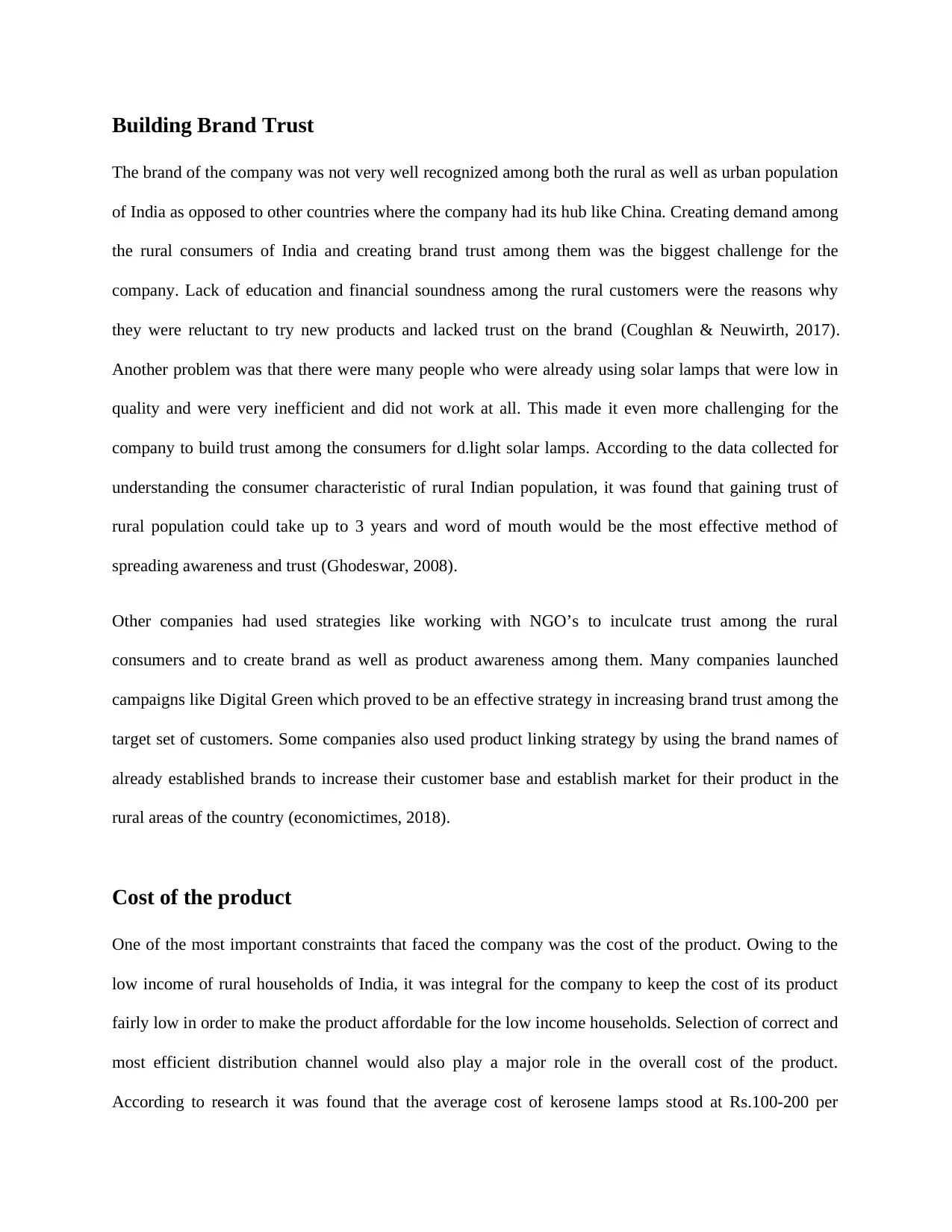
Building Brand Trust
The brand of the company was not very well recognized among both the rural as well as urban population
of India as opposed to other countries where the company had its hub like China. Creating demand among
the rural consumers of India and creating brand trust among them was the biggest challenge for the
company. Lack of education and financial soundness among the rural customers were the reasons why
they were reluctant to try new products and lacked trust on the brand (Coughlan & Neuwirth, 2017).
Another problem was that there were many people who were already using solar lamps that were low in
quality and were very inefficient and did not work at all. This made it even more challenging for the
company to build trust among the consumers for d.light solar lamps. According to the data collected for
understanding the consumer characteristic of rural Indian population, it was found that gaining trust of
rural population could take up to 3 years and word of mouth would be the most effective method of
spreading awareness and trust (Ghodeswar, 2008).
Other companies had used strategies like working with NGO’s to inculcate trust among the rural
consumers and to create brand as well as product awareness among them. Many companies launched
campaigns like Digital Green which proved to be an effective strategy in increasing brand trust among the
target set of customers. Some companies also used product linking strategy by using the brand names of
already established brands to increase their customer base and establish market for their product in the
rural areas of the country (economictimes, 2018).
Cost of the product
One of the most important constraints that faced the company was the cost of the product. Owing to the
low income of rural households of India, it was integral for the company to keep the cost of its product
fairly low in order to make the product affordable for the low income households. Selection of correct and
most efficient distribution channel would also play a major role in the overall cost of the product.
According to research it was found that the average cost of kerosene lamps stood at Rs.100-200 per
The brand of the company was not very well recognized among both the rural as well as urban population
of India as opposed to other countries where the company had its hub like China. Creating demand among
the rural consumers of India and creating brand trust among them was the biggest challenge for the
company. Lack of education and financial soundness among the rural customers were the reasons why
they were reluctant to try new products and lacked trust on the brand (Coughlan & Neuwirth, 2017).
Another problem was that there were many people who were already using solar lamps that were low in
quality and were very inefficient and did not work at all. This made it even more challenging for the
company to build trust among the consumers for d.light solar lamps. According to the data collected for
understanding the consumer characteristic of rural Indian population, it was found that gaining trust of
rural population could take up to 3 years and word of mouth would be the most effective method of
spreading awareness and trust (Ghodeswar, 2008).
Other companies had used strategies like working with NGO’s to inculcate trust among the rural
consumers and to create brand as well as product awareness among them. Many companies launched
campaigns like Digital Green which proved to be an effective strategy in increasing brand trust among the
target set of customers. Some companies also used product linking strategy by using the brand names of
already established brands to increase their customer base and establish market for their product in the
rural areas of the country (economictimes, 2018).
Cost of the product
One of the most important constraints that faced the company was the cost of the product. Owing to the
low income of rural households of India, it was integral for the company to keep the cost of its product
fairly low in order to make the product affordable for the low income households. Selection of correct and
most efficient distribution channel would also play a major role in the overall cost of the product.
According to research it was found that the average cost of kerosene lamps stood at Rs.100-200 per
Paraphrase This Document
Need a fresh take? Get an instant paraphrase of this document with our AI Paraphraser
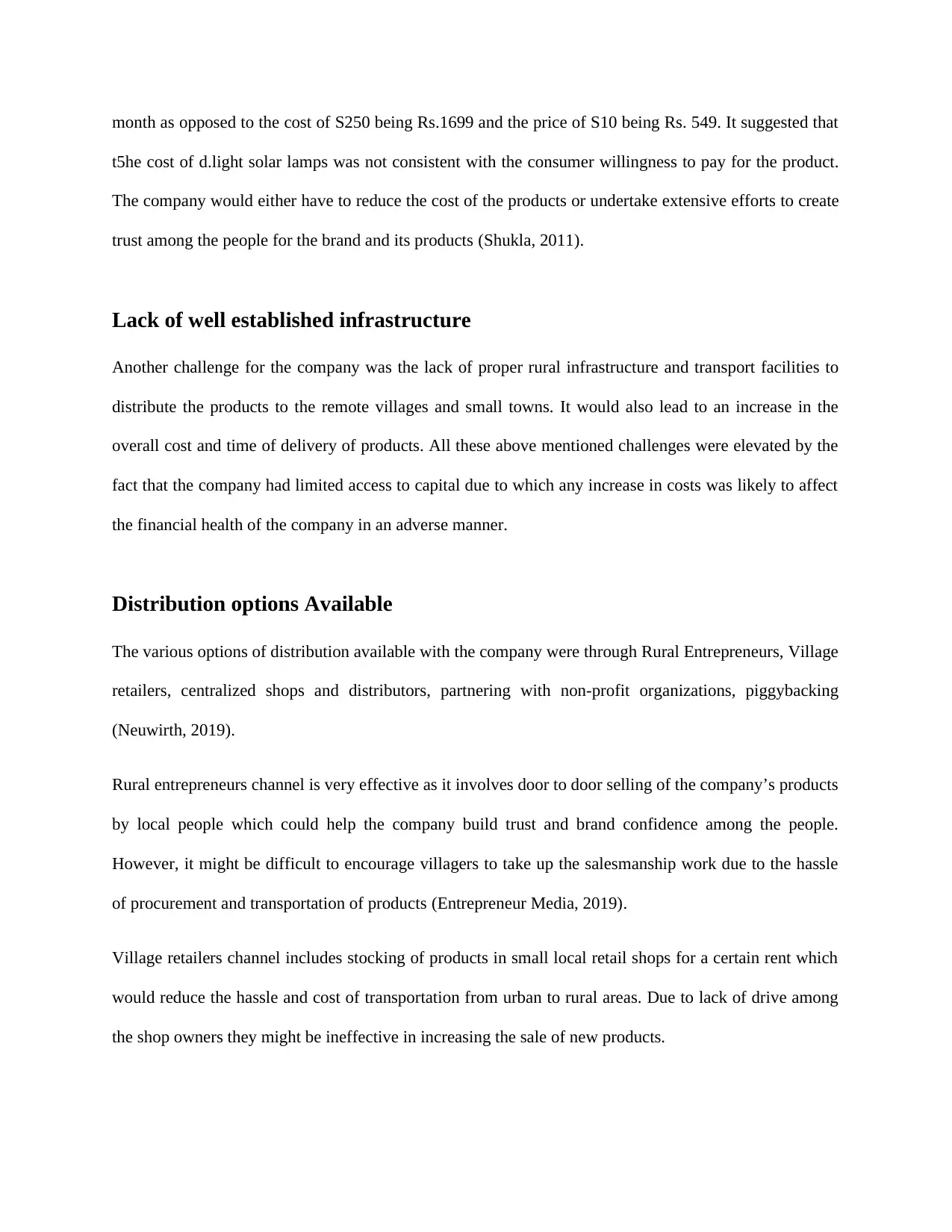
month as opposed to the cost of S250 being Rs.1699 and the price of S10 being Rs. 549. It suggested that
t5he cost of d.light solar lamps was not consistent with the consumer willingness to pay for the product.
The company would either have to reduce the cost of the products or undertake extensive efforts to create
trust among the people for the brand and its products (Shukla, 2011).
Lack of well established infrastructure
Another challenge for the company was the lack of proper rural infrastructure and transport facilities to
distribute the products to the remote villages and small towns. It would also lead to an increase in the
overall cost and time of delivery of products. All these above mentioned challenges were elevated by the
fact that the company had limited access to capital due to which any increase in costs was likely to affect
the financial health of the company in an adverse manner.
Distribution options Available
The various options of distribution available with the company were through Rural Entrepreneurs, Village
retailers, centralized shops and distributors, partnering with non-profit organizations, piggybacking
(Neuwirth, 2019).
Rural entrepreneurs channel is very effective as it involves door to door selling of the company’s products
by local people which could help the company build trust and brand confidence among the people.
However, it might be difficult to encourage villagers to take up the salesmanship work due to the hassle
of procurement and transportation of products (Entrepreneur Media, 2019).
Village retailers channel includes stocking of products in small local retail shops for a certain rent which
would reduce the hassle and cost of transportation from urban to rural areas. Due to lack of drive among
the shop owners they might be ineffective in increasing the sale of new products.
t5he cost of d.light solar lamps was not consistent with the consumer willingness to pay for the product.
The company would either have to reduce the cost of the products or undertake extensive efforts to create
trust among the people for the brand and its products (Shukla, 2011).
Lack of well established infrastructure
Another challenge for the company was the lack of proper rural infrastructure and transport facilities to
distribute the products to the remote villages and small towns. It would also lead to an increase in the
overall cost and time of delivery of products. All these above mentioned challenges were elevated by the
fact that the company had limited access to capital due to which any increase in costs was likely to affect
the financial health of the company in an adverse manner.
Distribution options Available
The various options of distribution available with the company were through Rural Entrepreneurs, Village
retailers, centralized shops and distributors, partnering with non-profit organizations, piggybacking
(Neuwirth, 2019).
Rural entrepreneurs channel is very effective as it involves door to door selling of the company’s products
by local people which could help the company build trust and brand confidence among the people.
However, it might be difficult to encourage villagers to take up the salesmanship work due to the hassle
of procurement and transportation of products (Entrepreneur Media, 2019).
Village retailers channel includes stocking of products in small local retail shops for a certain rent which
would reduce the hassle and cost of transportation from urban to rural areas. Due to lack of drive among
the shop owners they might be ineffective in increasing the sale of new products.
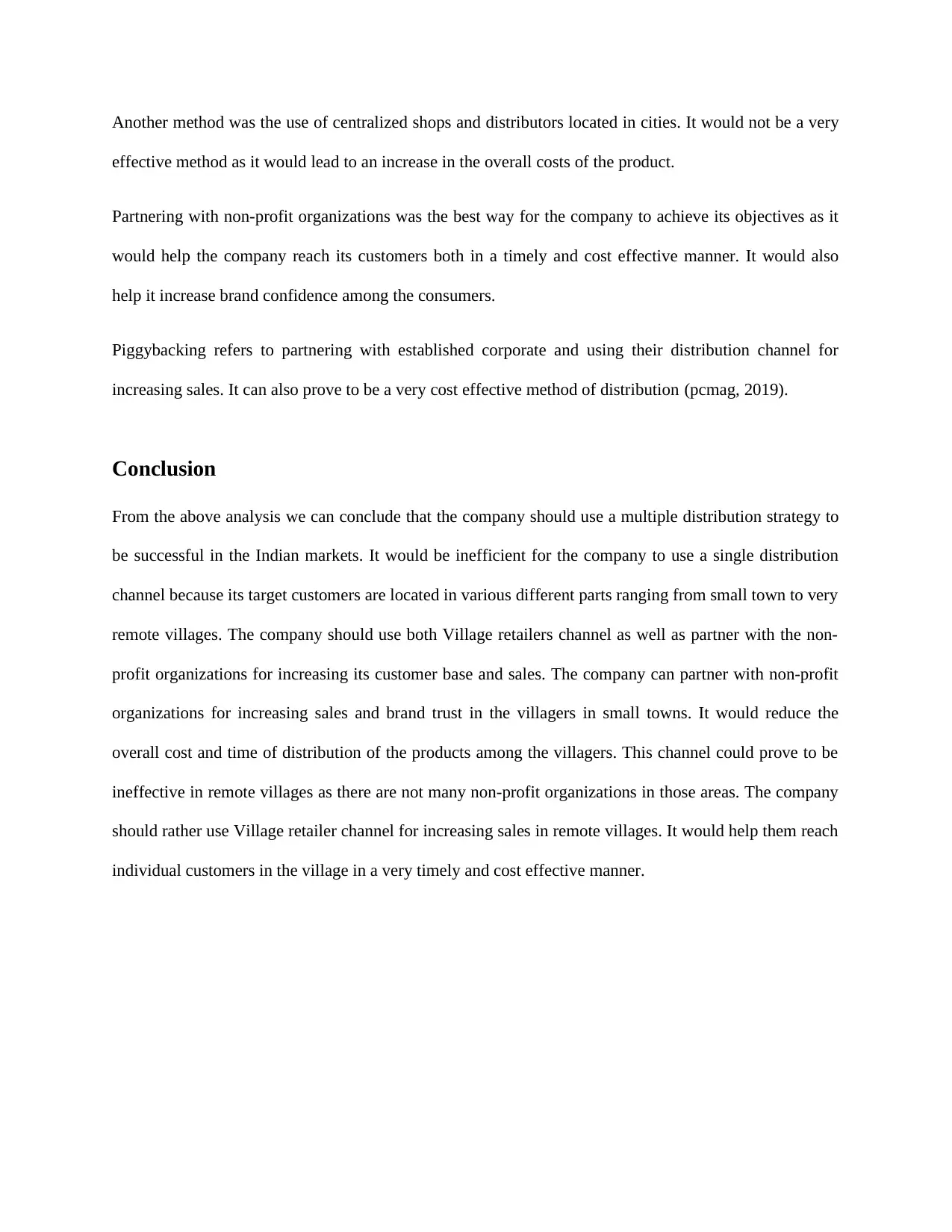
Another method was the use of centralized shops and distributors located in cities. It would not be a very
effective method as it would lead to an increase in the overall costs of the product.
Partnering with non-profit organizations was the best way for the company to achieve its objectives as it
would help the company reach its customers both in a timely and cost effective manner. It would also
help it increase brand confidence among the consumers.
Piggybacking refers to partnering with established corporate and using their distribution channel for
increasing sales. It can also prove to be a very cost effective method of distribution (pcmag, 2019).
Conclusion
From the above analysis we can conclude that the company should use a multiple distribution strategy to
be successful in the Indian markets. It would be inefficient for the company to use a single distribution
channel because its target customers are located in various different parts ranging from small town to very
remote villages. The company should use both Village retailers channel as well as partner with the non-
profit organizations for increasing its customer base and sales. The company can partner with non-profit
organizations for increasing sales and brand trust in the villagers in small towns. It would reduce the
overall cost and time of distribution of the products among the villagers. This channel could prove to be
ineffective in remote villages as there are not many non-profit organizations in those areas. The company
should rather use Village retailer channel for increasing sales in remote villages. It would help them reach
individual customers in the village in a very timely and cost effective manner.
effective method as it would lead to an increase in the overall costs of the product.
Partnering with non-profit organizations was the best way for the company to achieve its objectives as it
would help the company reach its customers both in a timely and cost effective manner. It would also
help it increase brand confidence among the consumers.
Piggybacking refers to partnering with established corporate and using their distribution channel for
increasing sales. It can also prove to be a very cost effective method of distribution (pcmag, 2019).
Conclusion
From the above analysis we can conclude that the company should use a multiple distribution strategy to
be successful in the Indian markets. It would be inefficient for the company to use a single distribution
channel because its target customers are located in various different parts ranging from small town to very
remote villages. The company should use both Village retailers channel as well as partner with the non-
profit organizations for increasing its customer base and sales. The company can partner with non-profit
organizations for increasing sales and brand trust in the villagers in small towns. It would reduce the
overall cost and time of distribution of the products among the villagers. This channel could prove to be
ineffective in remote villages as there are not many non-profit organizations in those areas. The company
should rather use Village retailer channel for increasing sales in remote villages. It would help them reach
individual customers in the village in a very timely and cost effective manner.
⊘ This is a preview!⊘
Do you want full access?
Subscribe today to unlock all pages.

Trusted by 1+ million students worldwide
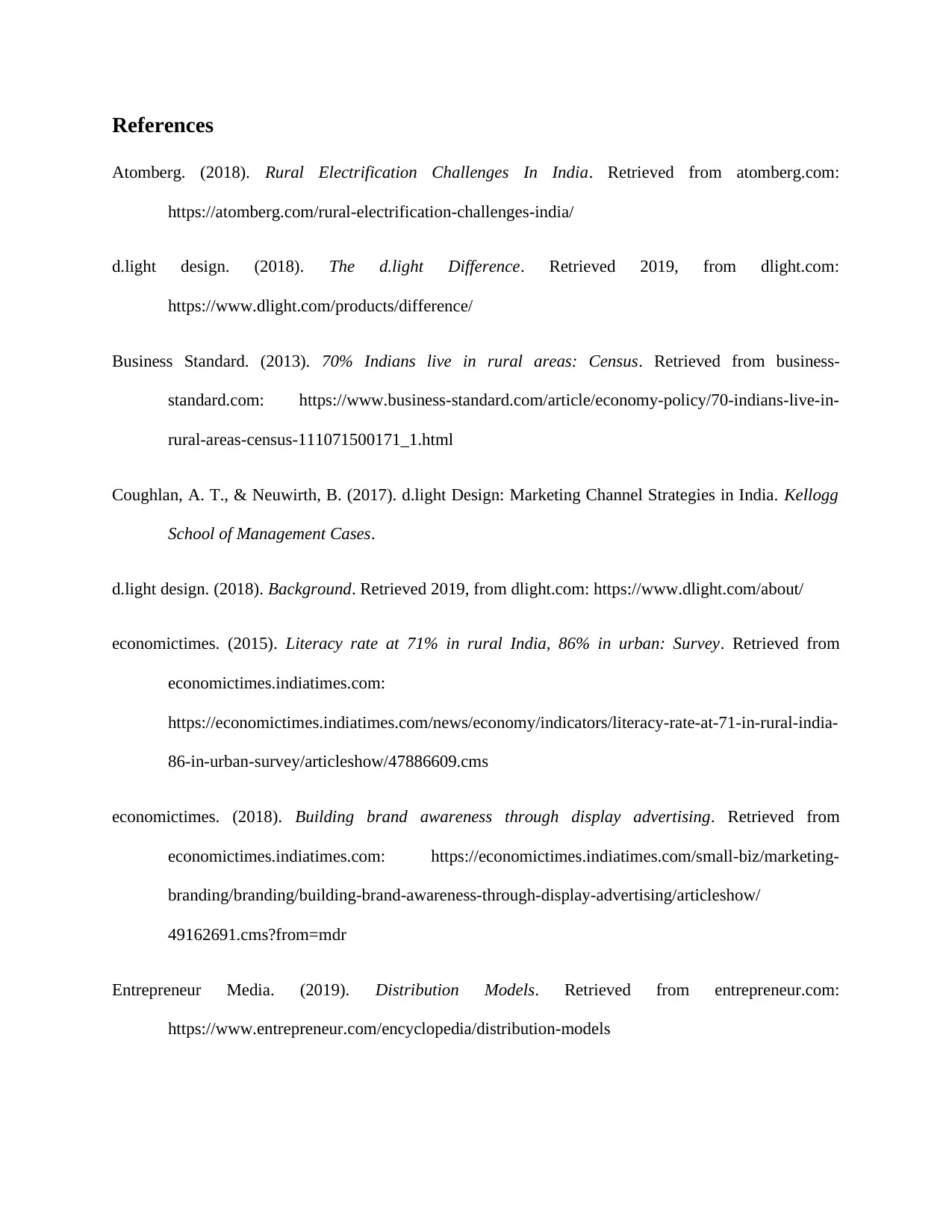
References
Atomberg. (2018). Rural Electrification Challenges In India. Retrieved from atomberg.com:
https://atomberg.com/rural-electrification-challenges-india/
d.light design. (2018). The d.light Difference. Retrieved 2019, from dlight.com:
https://www.dlight.com/products/difference/
Business Standard. (2013). 70% Indians live in rural areas: Census. Retrieved from business-
standard.com: https://www.business-standard.com/article/economy-policy/70-indians-live-in-
rural-areas-census-111071500171_1.html
Coughlan, A. T., & Neuwirth, B. (2017). d.light Design: Marketing Channel Strategies in India. Kellogg
School of Management Cases.
d.light design. (2018). Background. Retrieved 2019, from dlight.com: https://www.dlight.com/about/
economictimes. (2015). Literacy rate at 71% in rural India, 86% in urban: Survey. Retrieved from
economictimes.indiatimes.com:
https://economictimes.indiatimes.com/news/economy/indicators/literacy-rate-at-71-in-rural-india-
86-in-urban-survey/articleshow/47886609.cms
economictimes. (2018). Building brand awareness through display advertising. Retrieved from
economictimes.indiatimes.com: https://economictimes.indiatimes.com/small-biz/marketing-
branding/branding/building-brand-awareness-through-display-advertising/articleshow/
49162691.cms?from=mdr
Entrepreneur Media. (2019). Distribution Models. Retrieved from entrepreneur.com:
https://www.entrepreneur.com/encyclopedia/distribution-models
Atomberg. (2018). Rural Electrification Challenges In India. Retrieved from atomberg.com:
https://atomberg.com/rural-electrification-challenges-india/
d.light design. (2018). The d.light Difference. Retrieved 2019, from dlight.com:
https://www.dlight.com/products/difference/
Business Standard. (2013). 70% Indians live in rural areas: Census. Retrieved from business-
standard.com: https://www.business-standard.com/article/economy-policy/70-indians-live-in-
rural-areas-census-111071500171_1.html
Coughlan, A. T., & Neuwirth, B. (2017). d.light Design: Marketing Channel Strategies in India. Kellogg
School of Management Cases.
d.light design. (2018). Background. Retrieved 2019, from dlight.com: https://www.dlight.com/about/
economictimes. (2015). Literacy rate at 71% in rural India, 86% in urban: Survey. Retrieved from
economictimes.indiatimes.com:
https://economictimes.indiatimes.com/news/economy/indicators/literacy-rate-at-71-in-rural-india-
86-in-urban-survey/articleshow/47886609.cms
economictimes. (2018). Building brand awareness through display advertising. Retrieved from
economictimes.indiatimes.com: https://economictimes.indiatimes.com/small-biz/marketing-
branding/branding/building-brand-awareness-through-display-advertising/articleshow/
49162691.cms?from=mdr
Entrepreneur Media. (2019). Distribution Models. Retrieved from entrepreneur.com:
https://www.entrepreneur.com/encyclopedia/distribution-models
Paraphrase This Document
Need a fresh take? Get an instant paraphrase of this document with our AI Paraphraser
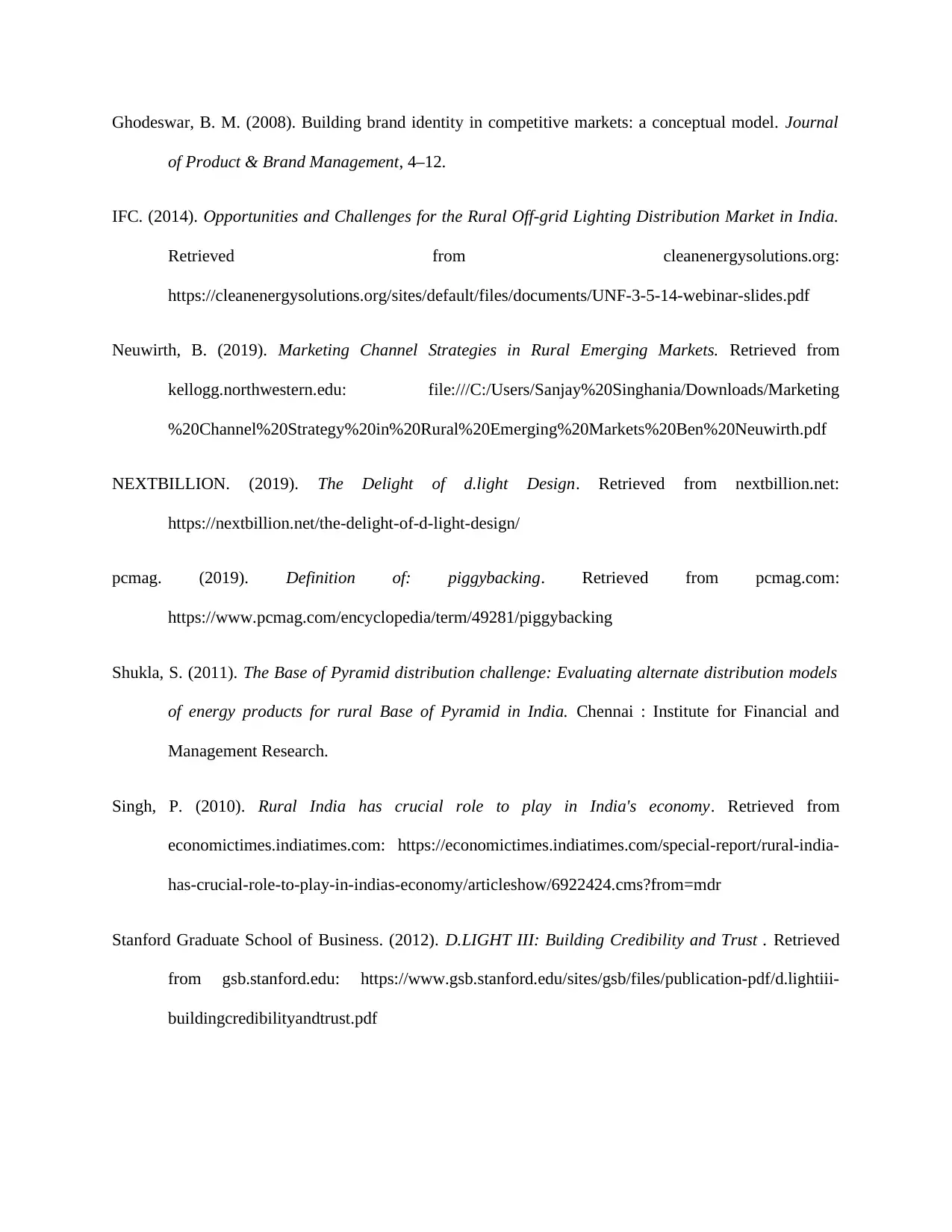
Ghodeswar, B. M. (2008). Building brand identity in competitive markets: a conceptual model. Journal
of Product & Brand Management, 4–12.
IFC. (2014). Opportunities and Challenges for the Rural Off-grid Lighting Distribution Market in India.
Retrieved from cleanenergysolutions.org:
https://cleanenergysolutions.org/sites/default/files/documents/UNF-3-5-14-webinar-slides.pdf
Neuwirth, B. (2019). Marketing Channel Strategies in Rural Emerging Markets. Retrieved from
kellogg.northwestern.edu: file:///C:/Users/Sanjay%20Singhania/Downloads/Marketing
%20Channel%20Strategy%20in%20Rural%20Emerging%20Markets%20Ben%20Neuwirth.pdf
NEXTBILLION. (2019). The Delight of d.light Design. Retrieved from nextbillion.net:
https://nextbillion.net/the-delight-of-d-light-design/
pcmag. (2019). Definition of: piggybacking. Retrieved from pcmag.com:
https://www.pcmag.com/encyclopedia/term/49281/piggybacking
Shukla, S. (2011). The Base of Pyramid distribution challenge: Evaluating alternate distribution models
of energy products for rural Base of Pyramid in India. Chennai : Institute for Financial and
Management Research.
Singh, P. (2010). Rural India has crucial role to play in India's economy. Retrieved from
economictimes.indiatimes.com: https://economictimes.indiatimes.com/special-report/rural-india-
has-crucial-role-to-play-in-indias-economy/articleshow/6922424.cms?from=mdr
Stanford Graduate School of Business. (2012). D.LIGHT III: Building Credibility and Trust . Retrieved
from gsb.stanford.edu: https://www.gsb.stanford.edu/sites/gsb/files/publication-pdf/d.lightiii-
buildingcredibilityandtrust.pdf
of Product & Brand Management, 4–12.
IFC. (2014). Opportunities and Challenges for the Rural Off-grid Lighting Distribution Market in India.
Retrieved from cleanenergysolutions.org:
https://cleanenergysolutions.org/sites/default/files/documents/UNF-3-5-14-webinar-slides.pdf
Neuwirth, B. (2019). Marketing Channel Strategies in Rural Emerging Markets. Retrieved from
kellogg.northwestern.edu: file:///C:/Users/Sanjay%20Singhania/Downloads/Marketing
%20Channel%20Strategy%20in%20Rural%20Emerging%20Markets%20Ben%20Neuwirth.pdf
NEXTBILLION. (2019). The Delight of d.light Design. Retrieved from nextbillion.net:
https://nextbillion.net/the-delight-of-d-light-design/
pcmag. (2019). Definition of: piggybacking. Retrieved from pcmag.com:
https://www.pcmag.com/encyclopedia/term/49281/piggybacking
Shukla, S. (2011). The Base of Pyramid distribution challenge: Evaluating alternate distribution models
of energy products for rural Base of Pyramid in India. Chennai : Institute for Financial and
Management Research.
Singh, P. (2010). Rural India has crucial role to play in India's economy. Retrieved from
economictimes.indiatimes.com: https://economictimes.indiatimes.com/special-report/rural-india-
has-crucial-role-to-play-in-indias-economy/articleshow/6922424.cms?from=mdr
Stanford Graduate School of Business. (2012). D.LIGHT III: Building Credibility and Trust . Retrieved
from gsb.stanford.edu: https://www.gsb.stanford.edu/sites/gsb/files/publication-pdf/d.lightiii-
buildingcredibilityandtrust.pdf
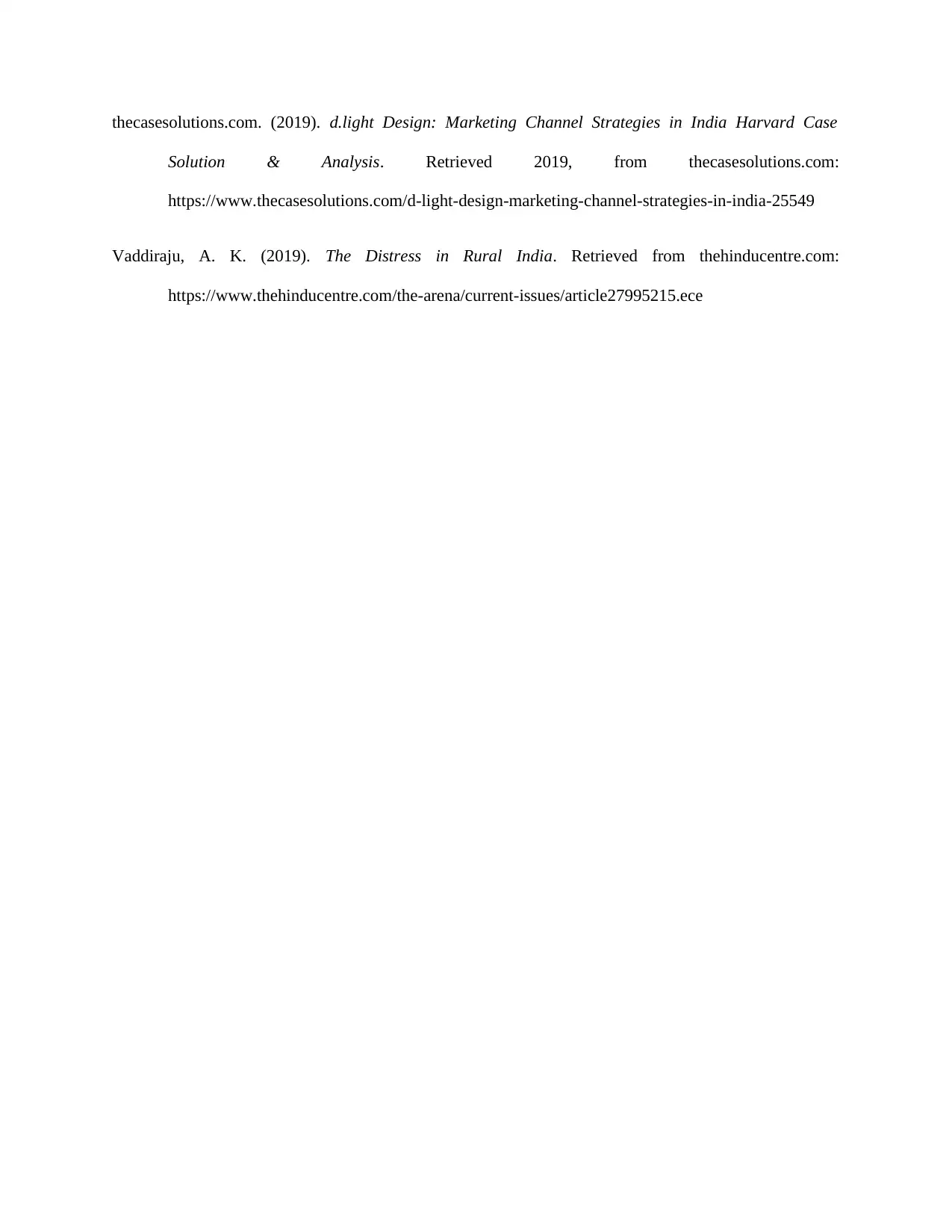
thecasesolutions.com. (2019). d.light Design: Marketing Channel Strategies in India Harvard Case
Solution & Analysis. Retrieved 2019, from thecasesolutions.com:
https://www.thecasesolutions.com/d-light-design-marketing-channel-strategies-in-india-25549
Vaddiraju, A. K. (2019). The Distress in Rural India. Retrieved from thehinducentre.com:
https://www.thehinducentre.com/the-arena/current-issues/article27995215.ece
Solution & Analysis. Retrieved 2019, from thecasesolutions.com:
https://www.thecasesolutions.com/d-light-design-marketing-channel-strategies-in-india-25549
Vaddiraju, A. K. (2019). The Distress in Rural India. Retrieved from thehinducentre.com:
https://www.thehinducentre.com/the-arena/current-issues/article27995215.ece
⊘ This is a preview!⊘
Do you want full access?
Subscribe today to unlock all pages.

Trusted by 1+ million students worldwide
1 out of 12
Your All-in-One AI-Powered Toolkit for Academic Success.
+13062052269
info@desklib.com
Available 24*7 on WhatsApp / Email
![[object Object]](/_next/static/media/star-bottom.7253800d.svg)
Unlock your academic potential
Copyright © 2020–2025 A2Z Services. All Rights Reserved. Developed and managed by ZUCOL.

